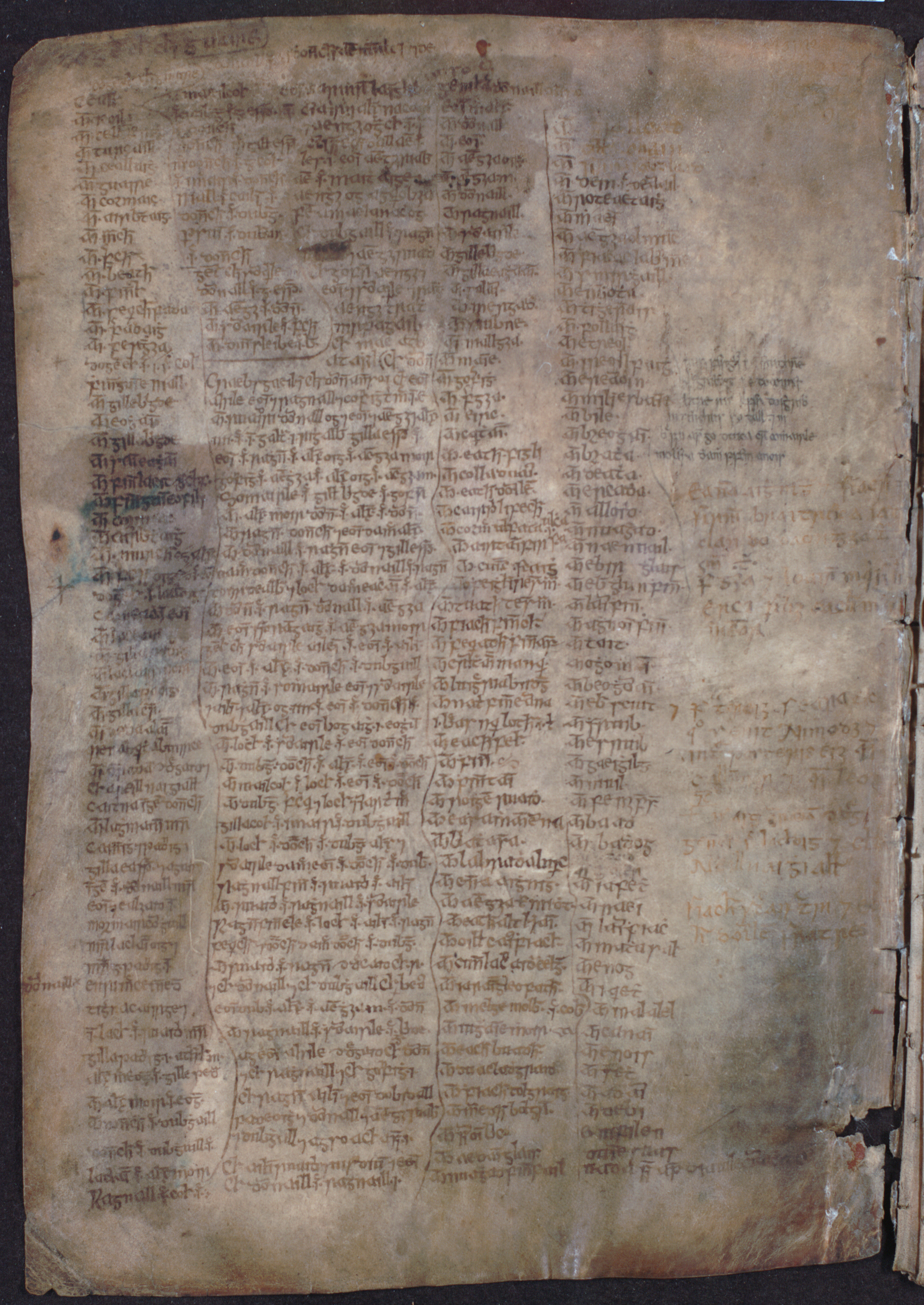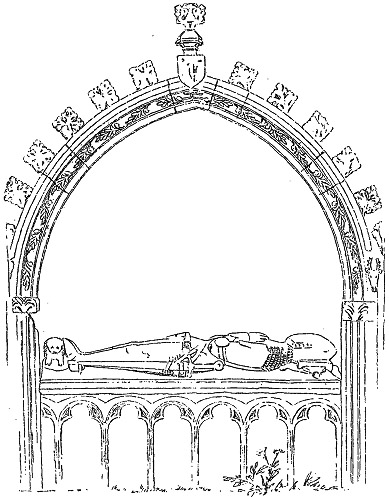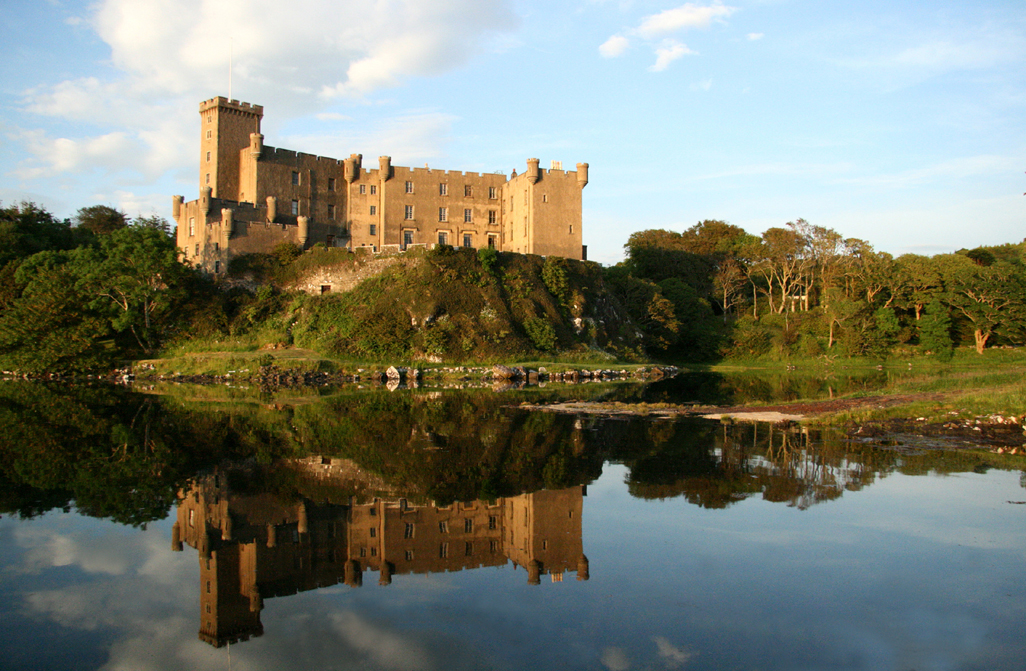|
Paul Mactire
Paul Mactire, also known as Paul MacTyre, and Paul M'Tyre, was a 14th-century Scotsman who lived in the north of Scotland. He appears in several contemporary records, as well as in a 15th-century genealogy which records his supposed ancestry. He is known to have married a niece of the brother of the Earl of Ross. According to later tradition, he was a notorious robber, or freebooter in the north of Scotland; Watson 1904: pp. 12–14. and, according to local tradition, he was the builder of a now ruinous fortress in Sutherland. He is said to be the ancestor of several Scottish families. According to some sources Paul Mactire's father was Leod Macgilleandrais. Contemporary records In 1365, Hugh of Ross, Lord of Fylorth, the brother of William III, Earl of Ross, granted to the lands of "Tutumtarvok", "Turnok", "Amot", and "Langville", in " Strathokel", to Paul and his wife, "Mariot of Graham", and their lineal descendants. Paul's wife was the niece of Hugh. The next year, Wil ... [...More Info...] [...Related Items...] OR: [Wikipedia] [Google] [Baidu] |
MS 1467
MS 1467, earlier known as MS 1450, is a mediaeval Gaelic manuscript which contains numerous pedigrees for many prominent Scottish individuals and clans. Transcriptions of the genealogies within the text were first published in the early 19th century and have ever since been used by writers on the clan histories. The 19th century transcriptions and translations from the manuscript have long been considered inadequate; yet there is no modern, scholarly edition of the manuscript. Description of the manuscript The manuscript known as ''MS 1467'' is a mediaeval Gaelic manuscript held in the National Library of Scotland. The MS 1467 is one of two manuscripts which are bound together in a document known as the MS 72.1.1. The first section of the MS 72.1.1, folios 1–9, is the MS 1467; the second section is known as the ''Broad Book'', and dates to 1425. The MS 1467 is made of vellum and measures . It was written by Dubhghall Albanach mac mhic Cathail; according to Ronnie Black, h ... [...More Info...] [...Related Items...] OR: [Wikipedia] [Google] [Baidu] |
Clan Mackenzie
Clan Mackenzie ( gd, Clann Choinnich ) is a Scottish clan, traditionally associated with Kintail and lands in Ross-shire in the Scottish Highlands. Traditional genealogies trace the ancestors of the Mackenzie chiefs to the 12th century. However, the earliest Mackenzie chief recorded by contemporary evidence is Alexander Mackenzie of Kintail who died some time after 1471. Traditionally, during the Wars of Scottish Independence, the Mackenzies supported Robert the Bruce, but feuded with the Earls of Ross in the latter part of the 14th century. During the 15th and 16th-centuries the Mackenzies feuded with the neighboring clans of Munro and MacDonald. In the 17th century the Mackenzie chief was made Earl of Seaforth in the peerage of Scotland. During the Scottish Civil War of the 17th century the Mackenzies largely supported the Royalists. During the Jacobite rising of 1715 the chief and clan of Mackenzie supported the Jacobite cause. However, during the Jacobite rising of 1745 the ... [...More Info...] [...Related Items...] OR: [Wikipedia] [Google] [Baidu] |
King Of Denmark
The monarchy of Denmark is a constitutional political system, institution and a historic office of the Kingdom of Denmark. The Kingdom includes Denmark proper and the autonomous administrative division, autonomous territories of the Faroe Islands and Greenland. The Kingdom of Denmark was already consolidated in the 8th century, whose rulers are consistently referred to in Franks, Frankish sources (and in some late Frisians, Frisian sources) as "kings" (). Under the rule of King Gudfred in 804 the Kingdom may have included all the major provinces of medieval Denmark. The current unified Kingdom of Denmark was founded or re-united by the Vikings, Viking kings Gorm the Old and Harald Bluetooth in the 10th century. Originally an elective monarchy, it became hereditary monarchy, hereditary only in the 17th century during the reign of Frederick III of Denmark, Frederick III. A decisive transition to a constitutional monarchy occurred in 1849 with the writing of the first democrat ... [...More Info...] [...Related Items...] OR: [Wikipedia] [Google] [Baidu] |
Balnagown
Balnagown Castle is beside the village of Kildary in Easter Ross, part of the Highland area of Scotland. There has been a castle on the site since the 14th century, although the present building was remodelled in the 18th and 19th centuries. It is the ancestral home of the Chiefs of Clan Ross, although since the 1970s it has been owned by Egyptian-born businessman Mohamed Al-Fayed. It is protected as a category B listed building, and the grounds are included on the Inventory of Gardens and Designed Landscapes in Scotland, the national listing of significant gardens. History In the early 14th century, a castle was begun at Balnagown by Hugh, Mormaer (Earl) of Ross. Hugh was husband of Maud, sister of King Robert the Bruce, although after Hugh's death in 1333, his family lost royal favour and their lands were forfeit. Balnagown was acquired by a stepson of Hugh in 1375 who expanded the estate, a process which continued over the following centuries. On 11 November 1501 James IV ... [...More Info...] [...Related Items...] OR: [Wikipedia] [Google] [Baidu] |
Clan Ross
Clan Ross ( gd, Clann Anndrais ) is a Highland Scottish clan. The original chiefs of the clan were the original Earl of Ross, Earls of Ross. History Origins The first recorded chief of the Clan Ross was Fearchar, Earl of Ross, "Fearcher Mac an t-Sagirt" which in English meant "son of the priest" alluding to his Ó Beólláin descent from the hereditary Abbots of Applecross.Way, George and Squire, Romily. (1994). pp. 308–309. Fearchar helped King Alexander II of Scotland (1214–1249) crush a rebellion by Donald Bane, a rival claimant to the Scottish throne. Fearchar was knighted by the king and by 1234 he was officially recognized with the title of Earl of Ross. The Earl's son, Uilleam I, Earl of Ross, William was abducted in about 1250 in a revolt against the Earl's rule. However, he was rescued with help from the Clan Munro, Munros who were rewarded with lands and who became closely connected with their powerful benefactors. Wars of Scottish Independence During the Wars ... [...More Info...] [...Related Items...] OR: [Wikipedia] [Google] [Baidu] |
Heir
Inheritance is the practice of receiving private property, titles, debts, entitlements, privileges, rights, and obligations upon the death of an individual. The rules of inheritance differ among societies and have changed over time. Officially bequeathing private property and/or debts can be performed by a testator via will, as attested by a notary or by other lawful means. Terminology In law, an ''heir'' is a person who is entitled to receive a share of the deceased's (the person who died) property, subject to the rules of inheritance in the jurisdiction of which the deceased was a citizen or where the deceased (decedent) died or owned property at the time of death. The inheritance may be either under the terms of a will or by intestate laws if the deceased had no will. However, the will must comply with the laws of the jurisdiction at the time it was created or it will be declared invalid (for example, some states do not recognise handwritten wills as valid, or only in s ... [...More Info...] [...Related Items...] OR: [Wikipedia] [Google] [Baidu] |
Alexander Mackenzie (historian)
Alexander is a male given name. The most prominent bearer of the name is Alexander the Great, the king of the Ancient Greek kingdom of Macedonia (ancient kingdom), Macedonia who created one of the largest empires in ancient history. Variants listed here are Aleksandar, Aleksander and Aleksandr. Related names and diminutives include Iskandar, Alec, Alek, Alex, Alexandre (given name), Alexandre, Aleks (given name), Aleks, Aleksa (given name), Aleksa and Sander (name), Sander; feminine forms include Alexandra, Alexandria (given name), Alexandria, and Sasha (name), Sasha. Etymology The name ''Alexander'' originates from the (; 'defending men' or 'protector of men'). It is a compound of the verb (; 'to ward off, avert, defend') and the noun (, genetive, genitive: , ; meaning 'man'). It is an example of the widespread motif of Greek names expressing "battle-prowess", in this case the ability to withstand or push back an enemy shield wall, battle line. The earliest Attested langua ... [...More Info...] [...Related Items...] OR: [Wikipedia] [Google] [Baidu] |
Clan MacLeod
Clan MacLeod (; gd, Clann Mac Leòid ) is a Highland Scottish clan associated with the Isle of Skye. There are two main branches of the clan: the MacLeods of Harris and Dunvegan, whose chief is MacLeod of MacLeod, are known in Gaelic as ' ("seed of Tormod"); the Clan MacLeod of Lewis and Raasay, whose chief is MacLeod of The Lewes ( gd, Mac Ghille Chaluim), are known in Gaelic as ' ("seed of Torcall"). Both branches claim descent from Leòd, who lived in the 13th century. Today, Clan MacLeod of The Lewes, Clan MacLeod of Raasay, and Clan MacLeod are represented by "Associated Clan MacLeod Societies", and the chiefs of the three clans. The association is made up of ten national societies across the world including: Australia, Canada, England, France, Germany, New Zealand, Scotland, South Africa, Switzerland, and the United States. History Origins The surname MacLeod means 'son of Leod'. The name Leod is an Anglicization of the Scottish Gaelic name Leòd, which is thought to ... [...More Info...] [...Related Items...] OR: [Wikipedia] [Google] [Baidu] |
Skye
The Isle of Skye, or simply Skye (; gd, An t-Eilean Sgitheanach or ; sco, Isle o Skye), is the largest and northernmost of the major islands in the Inner Hebrides of Scotland. The island's peninsulas radiate from a mountainous hub dominated by the Cuillin, the rocky slopes of which provide some of the most dramatic mountain scenery in the country. Slesser (1981) p. 19. Although has been suggested to describe a winged shape, no definitive agreement exists as to the name's origins. The island has been occupied since the Mesolithic period, and over its history has been occupied at various times by Celtic tribes including the Picts and the Gaels, Scandinavian Vikings, and most notably the powerful integrated Norse-Gaels clans of MacLeod and MacDonald. The island was considered to be under Norwegian suzerainty until the 1266 Treaty of Perth, which transferred control over to Scotland. The 18th-century Jacobite risings led to the breaking-up of the clan system and later clearanc ... [...More Info...] [...Related Items...] OR: [Wikipedia] [Google] [Baidu] |
Páll Bálkason
Páll, son of Bálki, or Paal Baalkeson, was a 13th-century Hebridean lord who was an ally of Olaf the Black, king of Mann and the Isles. He was long remembered in Gaelic tradition and is traditionally the progenitor of certain families with roots in the Hebrides. Páll is recorded as being a "sheriff" of Skye, a post which had earlier been held by another ''Páll, son of Bálki'', who was possibly an ancestor. This earlier sheriff was said to have been a close friend of Godred II, King of Mann and the Isles. Background Much of the contemporary knowledge of Páll comes from his appearances in the mediaeval ''Chronicle of Mann'' and later MacLeod tradition. Within the ''Chronicle of Mann'' he is named as ''Paul filius Boke'', and is titled as a ''vicecomes'' of Skye. This title has usually been translated into English as "sheriff", since it is the regular form of "sheriff" in later times in Scotland. According to W.D.H. Sellar, it is more likely that ''vicecomes'' refers to a No ... [...More Info...] [...Related Items...] OR: [Wikipedia] [Google] [Baidu] |




.jpg)



.jpeg)